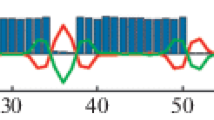Abstract
The flow pattern of ridges in a fingerprint is unique to the person in that no two people with the same fingerprints have yet been found. Fingerprints have been in use in forensic applications for many years and, more recently, in computer-automated identification and authentication. For automated fingerprint image matching, a machine representation of a fingerprint image is often a set of minutiae in the print; a minimal, but fundamental, representation is just a set of ridge endings and bifurcations. Oddly, however, after all the years of using minutiae, a precise definition of minutiae has never been formulated. We provide a formal definition of a minutia based on the gray scale image. This definition is constructive, in that, given a minutia image, the minutia location and orientation can be uniquely determined.
Access this chapter
Tax calculation will be finalised at checkout
Purchases are for personal use only
Preview
Unable to display preview. Download preview PDF.
Similar content being viewed by others
References
R.M. Bolle, S. Pankanti, N.K. Ratha and A.W. Senior, “Minutia exchange template format,” IEEE AutoID’99, Oct. 28–29, Summit NJ, pp. 74–77.
N.K. Ratha, S. Chen and A.K. Jain, “Adaptive flow orientation-based feature extraction in fingerprint images,” Pattern Recognition, Vol. 28, No. 11, pp. 1657–1672, 1995.
S. E. Schuster, Fingerprinting method, IBM Technical Disclosure Bulletin: 12–70, p. 1852. Dec. 1970.
C. Tsikos, “Capacitive fingerprint sensor,” US Patent 4353056, 1982.
“The science of fingerprints-Classification and uses,” US Department of Justice, Federal Bureau of Investigations.
M.D. Garris and R.M. McCabe “NIST Special Database 27: Fingerprint Minutiae from Latent and Matching Tenprint Images”, National Institute of Standards and Technology, Technical Report NISTIR 6534.
AAMVA National Standard for the Driver License/Identification Card American Association of Motor Vehicle Associations. AAMVA DL/ID-2000 http://www.aamva.org/standards/stdaamvadlidstandard2000.asp
Author information
Authors and Affiliations
Editor information
Editors and Affiliations
Rights and permissions
Copyright information
© 2002 Springer-Verlag Berlin Heidelberg
About this paper
Cite this paper
Bolle, R.M., Senior, A.W., Ratha, N.K., Pankanti, S. (2002). Fingerprint Minutiae: A Constructive Definition. In: Tistarelli, M., Bigun, J., Jain, A.K. (eds) Biometric Authentication. BioAW 2002. Lecture Notes in Computer Science, vol 2359. Springer, Berlin, Heidelberg. https://doi.org/10.1007/3-540-47917-1_7
Download citation
DOI: https://doi.org/10.1007/3-540-47917-1_7
Published:
Publisher Name: Springer, Berlin, Heidelberg
Print ISBN: 978-3-540-43723-9
Online ISBN: 978-3-540-47917-8
eBook Packages: Springer Book Archive




